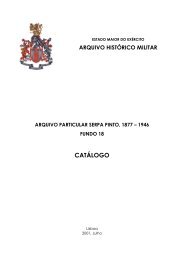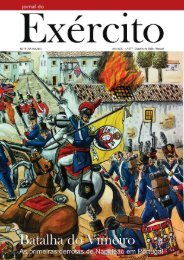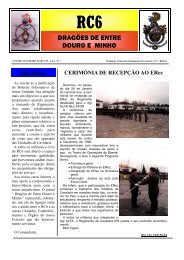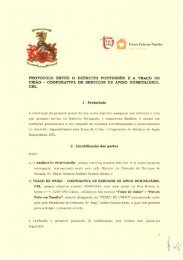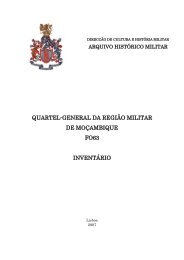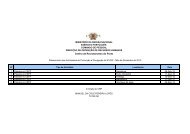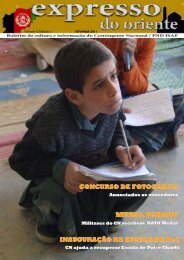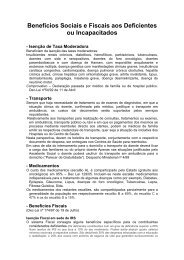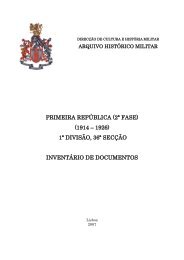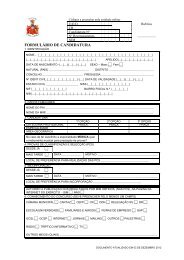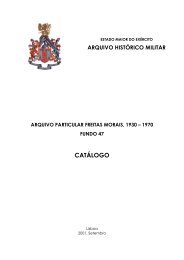Edição nº 195 - Exército
Edição nº 195 - Exército
Edição nº 195 - Exército
You also want an ePaper? Increase the reach of your titles
YUMPU automatically turns print PDFs into web optimized ePapers that Google loves.
28 - Temas Gerais<br />
means 12 machine cannon Wiesel). Additional we have in the Paratrooper<br />
Battalion one dog platoon (search for persons/explosive ordnance)<br />
and one special paratroopers platoon to prepare and secure<br />
landing zones for the incoming paratroopers (this special platoon are<br />
free fallers). For the Mountain Infantry Battalion the difference is not<br />
serious, they have only one additional high-mountain platoon and<br />
one mountain pack animal company for logistic support on alpine<br />
operations.<br />
The Commander of an Infantry Battalion is now able to<br />
employ his forces supported by the heavy Company with various<br />
intents on the battlefield:<br />
••<br />
Support combat op by quick reaction indirect fire weapons<br />
(up to 6350 m) against area, point and single targets;<br />
••<br />
Engage with long range anti tank capacities (up to<br />
3750 m):<br />
––<br />
to form point of main effort in anti tank issues;<br />
––<br />
to destroy hostile tanks and armored infantry fighting<br />
vehicles;<br />
––<br />
to act against enemy behind strong fighting positions;<br />
––<br />
to engage helicopters;<br />
––<br />
to protect and screen the flanks;<br />
••<br />
Engage with machine cannons 20 mm by direct fire<br />
(up to 1200 m):<br />
––<br />
to support and reinforce dismounted Infantry;<br />
––<br />
to fight against light and soft skinned vehicles;<br />
––<br />
to operate against enemy behind cover;<br />
––<br />
to act against low level airplanes;<br />
••<br />
Reconnaissance by recce platoon (up to 5000 m) - reconnoiter<br />
and observe Battalion´s area of responsibility;<br />
••<br />
Ensure quick concentration and displacement of forces.<br />
To break it down to an Infantry platoon, he is rather flexible<br />
as such even without supporting elements (see picture 2). All weapons<br />
in the sections have an effective radius of at least 200 m and<br />
deliver precise fire. Under favourable conditions sufficient accuracy<br />
is even provided out to 400 m. Some specifically qualified soldiers<br />
in the sections can effectively engage targets out to 600 m with<br />
selected weapons and in a favourable environment. The envisioned<br />
effective radius, within which the section must hold its ground with<br />
organic means and without any vehicle support, is 600 m. The weapons<br />
are not optimised for specific operational scenarios, but are<br />
designed to cover the entire target spectrum of an infantry section<br />
within its effective radius. The core question is: what is required for<br />
each soldier or the section in all scenarios<br />
The platoon leader has some flexibility through optional<br />
weapons to respond to the current threat. Additional flexibility is provided<br />
by the transport capacity of the BOXER Armoured Transport<br />
Vehicle, but the soldier‘s load, volume and training requirements are<br />
still subject to tight limits. The individual infantryman must remain<br />
a dismounted warrior rather than a mere weapons, optronics and<br />
protective equipment carrier or operator. This is especially true in<br />
difficult terrain and complex scenarios as for example in an urban<br />
environment.<br />
In the current operations, the infantryman‘s mobility is ensured<br />
primarily by transport vehicles. These vehicles must allow the<br />
soldiers to carry their equipment on board and to dismount fully<br />
equipped for the mission. We will concentrate on the BOXER with his<br />
10 soldiers; it is visible, that the infantry section comprises 2 fire teams,<br />
the driver and the gunner stay in/at the vehicle. If they are dismounted<br />
from the vehicle, each fire team is led by a sergeant. The different<br />
weapons of one squad are viewable on the picture 2. It comprises 7<br />
assault rifles, 2 light anti-tank weapons, 2 light machine guns, 2 grenade<br />
launchers, 1 designated marksman rifle, 2 machine pistols more<br />
a remote controlled weapon 200 with 12,7 mm or 40 mm.<br />
The BOXER Multi-Role Armoured Vehicle (MRAV) has proven<br />
successful on operations. The Boxer significantly adds to the<br />
infantry capabilities and considerably influences the operational procedures<br />
of the infantry platoons in certain scenarios. The BOXER<br />
is not an infantry fighting vehicle and will not convert light infantry<br />
forces into armoured infantry. The protected transport capacity and<br />
the four remote-control weapon stations per platoon, however, will<br />
offer additional options for various scenarios. It has to be underlined,<br />
though, that the light infantry will continue to predominantly<br />
conduct dismounted combat operations. Its organisational structure,<br />
command and control, training and equipment will be tailored to this<br />
role accordingly, and the potential of the BOXER will be an add-on<br />
for extraordinary situations.<br />
The Boxer is full integrated in the “Future Infantryman System”.<br />
Further transport vehicles to be mentioned are the HÄGGLUND<br />
used by the mountain infantry or the MUNGO Multi-Purpose Vehicle<br />
used by the airborne infantry. Since the BOXER is initially fielded in<br />
relatively small numbers, the FUCHS APC will continue to be in use.<br />
The DINGO and the EAGLE (for snipers) employed as special-purpose<br />
vehicles in the task forces will be the choice for the support<br />
weapon platoons.<br />
When the development process was launched and the military<br />
requirements were defined some time ago, the premise for a<br />
transport vehicle in a relatively secure area was “self-defence”. Today,<br />
the Remote-Control Weapons Stations (Fernbedienbare leichte<br />
Waffenstation) 100 and 200 are universal platforms for all protected<br />
vehicles of the Bundeswehr. The experiences from the ISAF mission<br />
produced the following premise: Wherever feasible and compliant<br />
with technical regulations, the ambition is to equip the vehicles with<br />
the heavier FLW 200 variant. There will be four BOXER in the infantry<br />
platoon, two of them with mounted heavy machine guns 12, 7 mm,<br />
the other two with automatic grenade launchers 40 mm.



